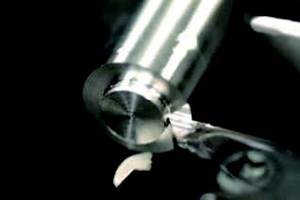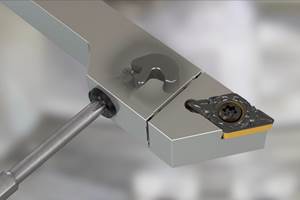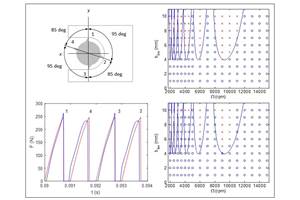Stepping Up To Hole-Making Challenges
Lately, several cutting tool manufacturers have re-examined indexable insert drills, seeking to overcome the disadvantages of unbalanced cutting forces inherent in their design. One of the most recent developments along these lines is the CoroDrill 880 introduced by Sandvik Coromant.
Share






This video demonstrates the use of stepped insert designs in hold making operations
The problem with many indexable insert drills is that they have two inserts whose cutting edges overlap to produce the correct cutting diameter. So even though the drill has two flutes, the inserts function as a single but asymmetrical cutting edge. Such designs are inherently unbalanced. As a result, indexable drills have had to compromise feed and speed when entering a cut, forcing the user to make a trade-off between economy and productivity.
Another problem with the unbalanced entry is hole tolerance. Typically, the center insert of an indexable drill enters first. This creates a large radial cutting force, which tends to cause deflection in the drill body. Once the drill is pushed off-center, it cannot produce a close-tolerance hole.
For these reasons, indexable drills have generally been limited to rough drilling of holes. Where tolerances closer than 0.012 to 0.016 inch total are required, it has been necessary to follow the indexable drill with a secondary operation.
Lately, several cutting tool manufacturers have re-examined indexable insert drills, seeking to overcome the disadvantages of unbalanced cutting forces inherent in their design. One of the most recent developments along these lines is the CoroDrill 880 introduced by Sandvik Coromant (Fair Lawn, New Jersey). According to Bruce Carter, a Sandvik product specialist, the design of this indexable drill sidesteps the problems created by unbalanced cutting forces, thus improving productivity and hole quality while retaining the economy of having inserts with four usable edges.
The key is a concept that the company calls "Step Technology." This phrase describes the "step-by-step" entrance of the insert cutting edges into the workpiece, which is said to greatly reduce the radial cutting forces associated with indexable drills in the past. The concept involves two inserts with different geometry and different cutting characteristics. The center insert has a noticeably irregular edge geometry, while the peripheral insert incorporates a wiper geometry.
In the first step of entering the workpiece, the outside corner of the center insert contacts the workpiece. This allows the drill to begin cutting with relatively low radial forces, minimizing deflection. In the second step, the outer corner of the peripheral insert contacts the workpiece. This balances the force generated by the center insert. In the third and last step, the remaining part of the central insert begins to cut. All three steps are indicated in the illustration (above).
Mr. Carter says that by entering the cut in three relatively small steps, the cutting forces are reduced to less than half those produced by typical insert drills, balancing each other so that deflection on entry is virtually eliminated. The combination of balanced entry, low radial cutting forces, and minimal deflection produces several benefits:
- More accurate hole tolerances.
- The possibility to increase feed rates as much as 100 percent, depending on material.
- The possibility to run drills as long as four or more times the diameter with more confidence.
- The possibility to eliminate secondary hole-sizing operations, depending on the tolerance demands.
Another benefit cited is that the design allows the peripheral insert to have four fully usable cutting edges. Some indexable drills with square inserts sacrifice the fourth cutting edge if feeds are above 0.005 ipr. However, with the Step Technology, the unusual shape of the central insert protects the fourth cutting edge at feeds as high as 0.013 ipr.
Finally, Mr. Carter points out that the wiper technology of the peripheral insert produces an excellent surface finish even at the higher feeds possible with the new design. In tests, surface finishes of 20 microinches were attained at feed rates of 0.004 ipr, and 80 to 120 microinches at feed rates as high as 0.013 ipr.
Related Content
Toolpath Improves Chip Management for Swiss-Type Lathes
This simple change to a Swiss-type turning machine’s toolpath can dramatically improve its ability to manage chips.
Read MoreQuick-Change Tool Heads Reduce Setup on Swiss-Type Turning Centers
This new quick-change tooling system enables shops to get more production from their Swiss turning centers through reduced tool setup time and matches the performance of a solid tool.
Read MoreBriquetting Manufacturer Tools Up for Faster Turnaround Times
To cut out laborious manual processes like hand-grinding, this briquette manufacturer revamped its machining and cutting tool arsenal for faster production.
Read MoreThe Impact of Cutting Teeth Spacing on Machining Stability
Many cutter designs are available, and variable teeth spacing (or variable pitch) cutters can be used to influence milling stability. Let’s discuss why teeth spacing affects stability.
Read MoreRead Next
Machine Shop MBA
Making Chips and 91ÊÓƵÍøÕ¾ÎÛ are teaming up for a new podcast series called Machine Shop MBA—designed to help manufacturers measure their success against the industry’s best. Through the lens of the Top Shops benchmarking program, the series explores the KPIs that set high-performing shops apart, from machine utilization and first-pass yield to employee engagement and revenue per employee.
Read MoreAMRs Are Moving Into Manufacturing: 4 Considerations for Implementation
AMRs can provide a flexible, easy-to-use automation platform so long as manufacturers choose a suitable task and prepare their facilities.
Read MoreLast Chance! 2025 Top Shops Benchmarking Survey Still Open Through April 30
Don’t miss out! 91ÊÓƵÍøÕ¾ÎÛ's Top Shops Benchmarking Survey is still open — but not for long. This is your last chance to a receive free, customized benchmarking report that includes actionable feedback across several shopfloor and business metrics.
Read More





















